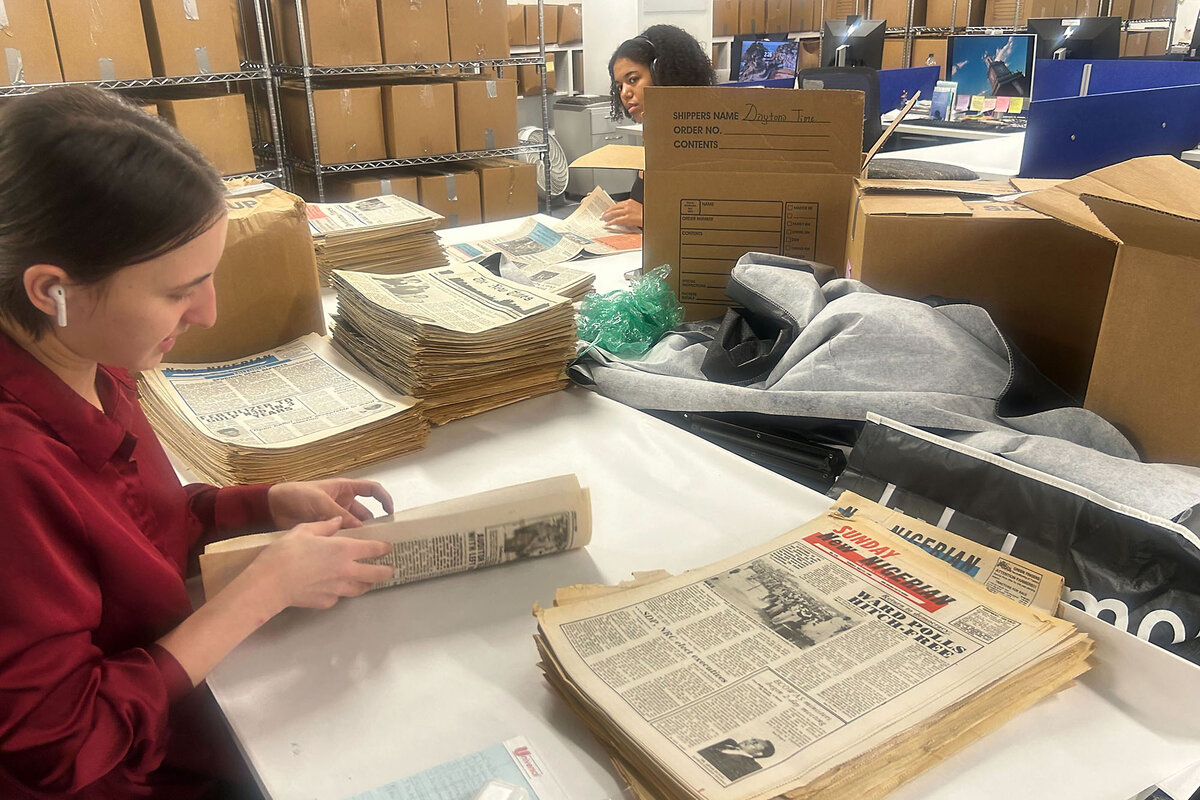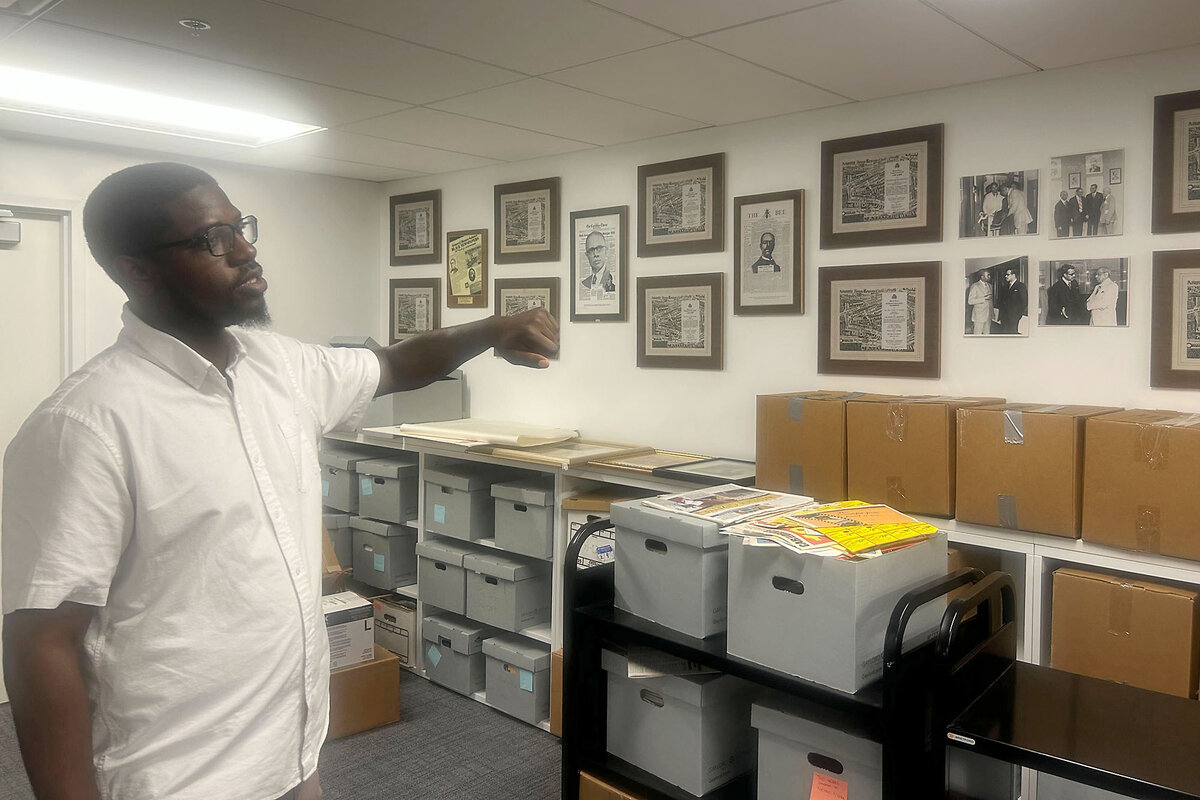‘We don’t even know all of what we have.’ Howard fights to preserve Black newspapers.
Loading...
| Washington
Brandon Nightingale walks to the stacks in the basement of Founders Library and opens a cardboard box. Inside sits a treasure that had been feared lost: The North Star. Abolitionist Frederick Douglass, who has a hall here on Howard University’s campus named for him, founded the antislavery newspaper in 1847. He named it after the star that enslaved people followed to freedom.
Last year, during a move, workers found two whole boxes of the newspaper’s first year of publication.
“When they came and said, ‘Hey, we found this. What do y’all want to do with it?’ – we were mind blown,” remembers Mr. Nightingale, senior project manager for the Black Press Archive digitization project, which operates from the library’s basement.
Why We Wrote This
Across the United States, scholars are working to preserve the history of the Black press before the brittle pages are lost forever. In a basement at Howard University, uncovered treasures have included Frederick Douglass’ newspaper, The North Star.
The papers haven’t been inventoried just yet.
“We don’t even know all of what we have,” Mr. Nightingale marvels.
The basement is a trove of artifacts, including old editions of Black-owned newspapers that tell the life of Black Americans during the 19th and 20th centuries. Articles cover slavery, lynchings, Jim Crow, and the Civil Rights era. The archive project, which is part of the university’s Moorland-Spingarn Research Center, is bringing to life the faces of yesterday by merging them with the digital world of today. This way, the hope is, they won’t be lost ever again.
It is just one of many efforts across the country to preserve the history of the Black press. Earlier this year, the Amsterdam News, started 115 years ago in New York City, that most of its Harlem building will be turned into a museum and community space. The Afro American Newspapers, which has more than 100 years of articles and photographs, also has an expansive archive collection in Baltimore.
“America does not have a full accounting of itself without the historic Black press,” says , author, investigative journalist, and professor at Morehouse College in Atlanta.
“I’ve argued that the Black press democratized America,” says Professor Carr, who won a 2025 prize from the American Society for Journalists and Authors for her thesis. She says that the pages of the Black press, particularly before newsrooms were mostly integrated during the Civil Rights era, told unvarnished stories of labor, resilience, and fortitude. Those stories examined themes that can serve as a beacon for journalism in a democracy.
“We know that it’s protected”
There might be another prize yet to be uncovered at Howard: The library is rumored to possess an original copy of Freedom’s Journal, the first Black newspaper in the country, from 1827. The Library of Congress has requested to see a copy when the center finds it.
Mr. Nightingale and his staff say it’s not lost on them that their work to give new life to Black Americans’ history is taking place just miles from the Smithsonian Institution’s National Museum of African American History and Culture. This past summer, President Donald Trump complained that the museum focused too much on the negatives of history and to conduct a review to make sure exhibits were aligned with the White House’s definition of patriotism.
“It’s something about it being here, we know that it’s protected. We know that nobody’s coming in these doors taking this down from Howard,” says Mr. Nightingale.
He and his staff of about 11 people, including students, have curated a digital collection of thousands of pages of the Black press. Some have been digitally preserved before the brittle pages of the original sheets they were printed on faded from history forever.
The project started in 2021, as part of a $2 million grant from the Jonathan Logan Family Foundation. This was in conjunction with National Newspaper Publishers Association, a trade organization made up of more than 200 Black-owned newspapers. Google also donated $760,000. Mr. Nightingale’s hope is that the center will become a part of Moorland-Spingarn’s budget in 2027. So far, he has secured $1.3 million from OpenAI, the Ford Foundation, and the Marguerite Casey Foundation to keep it going.
The project is digitizing U.S. newspapers that are 95 years or older, which are in the public domain. The center also has permission to place online certain newspapers still under copyright. Moorland-Spingarn has international Black papers from the Caribbean and Africa, but they will not be digitized. They are, however, available for researchers to visit and read, as well as U.S. papers not yet in the public domain.
‚ÄúWhen we‚Äôre thinking about our journalism and reckoning with the evolution of journalism, way too often, the Black press is discounted¬Ý‚Äì or it‚Äôs fed to those of us who are descendants of the diaspora, or a part of it, but not to everyone else,‚Äù says Professor Carr. People treat the Black press as a special thing instead of looking through its pages for instruction, she adds.
She applauds the move by Howard and other grassroots organizations to preserve the legacy of the Black press. It should be shared with the entirety of society, she says.
“You really want people to feel welcome”
In Flint, Michigan, where Black people make up¬Ý, Black newspapers can provide an important perspective on the city‚Äôs complicated history, says Callum Carr, an associate archivist at the University of Michigan, Flint, and who is no relation to the Morehouse professor. Preserving those newspapers, they add, is also a matter of respecting the community ‚Äì and representing history accurately.
“When you serve a community like Flint, that is so diverse and is so Black, you really want people to feel welcome in this archive and to feel represented and be represented properly,” says Carr.
Last year, Carr oversaw the launch of the Black Community Newspapers collection to do just that. It’s a partnership between the University of Michigan, the Genesee Historical Collections Center, and the Gloria Coles Flint Public Library that has been working for years to digitize the Black newspapers that covered Flint for much of its history.
So far, the project has :¬Ýthe Bronze Reporter, the Flint-Brownsville News, and the Flint Spokesman ‚Äì covering the late 1940s through the early 1960s. They chronicle everything about Black life, from slice-of-life stories about residents‚Äô vacations to heavier topics including police brutality and Jim Crow.
Now, Carr is working on archiving the second run of the Spokesman, which paused publication in the 1950s. During its second iteration, from 1971 to 1978, the paper covered urban-renewal programs, federal initiatives that sought to redress a range of perceived urban problems. These included unsanitary and unsafe housing, high crime, and infrastructure decay.
Such programs often neighborhoods in the name of removing blight. In Flint, the programs targeted neighborhoods such as Floral Park, which, as a result of redlining, was one of the few places in the city where Black people could own property. Municipal neglect led to the degradation of these neighborhoods. The construction of a highway interchange in the 1970s forced residents of Floral Park and surrounding communities from their homes and .
The aim of the archive, Carr says, is not only to remind residents of that history – and how it might impact the present day – but also of the vibrancy of Flint’s communities.
“The ’70s saw a very purposeful destruction of Black community, and reminding people of that community and showing what that community could look like is huge,” Carr says. “Hopefully, maybe, we can learn from these newspapers. ... Maybe looking at that history and seeing it still happen will inspire some sort of change.”






